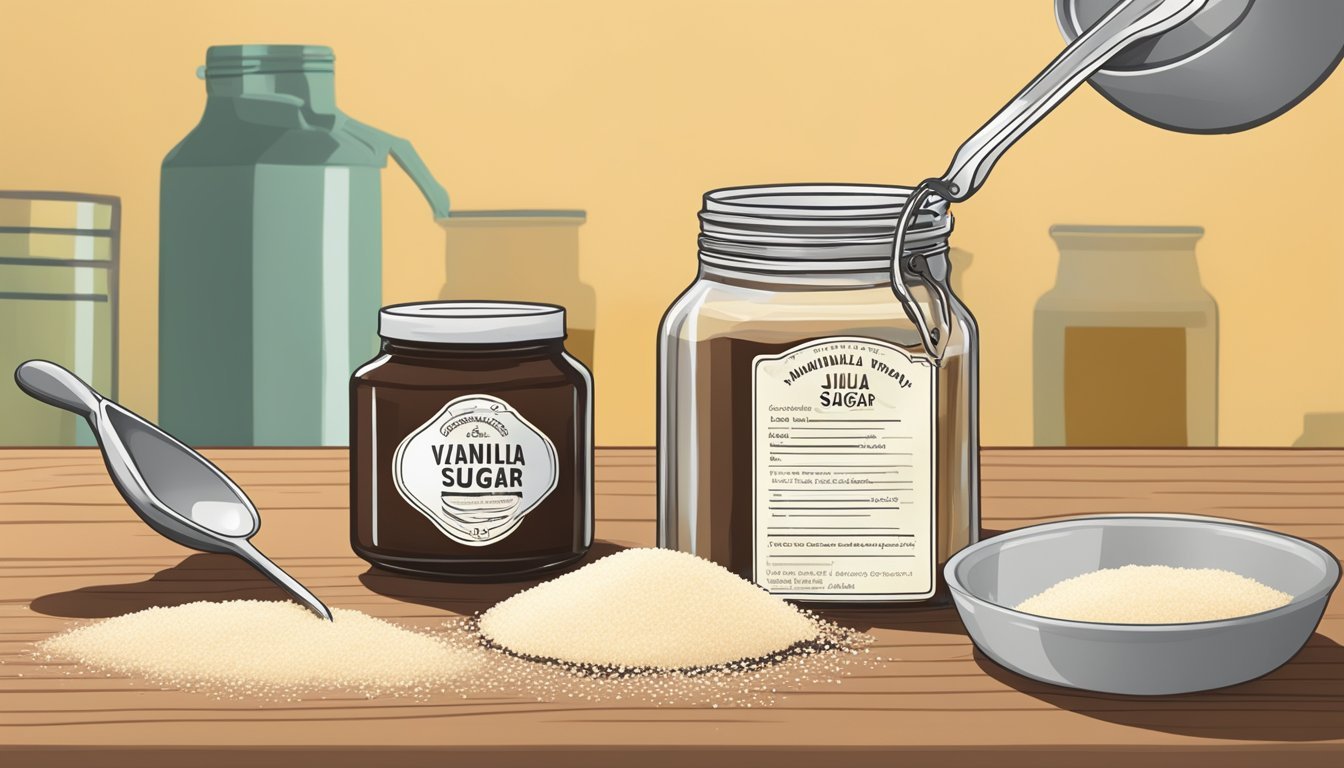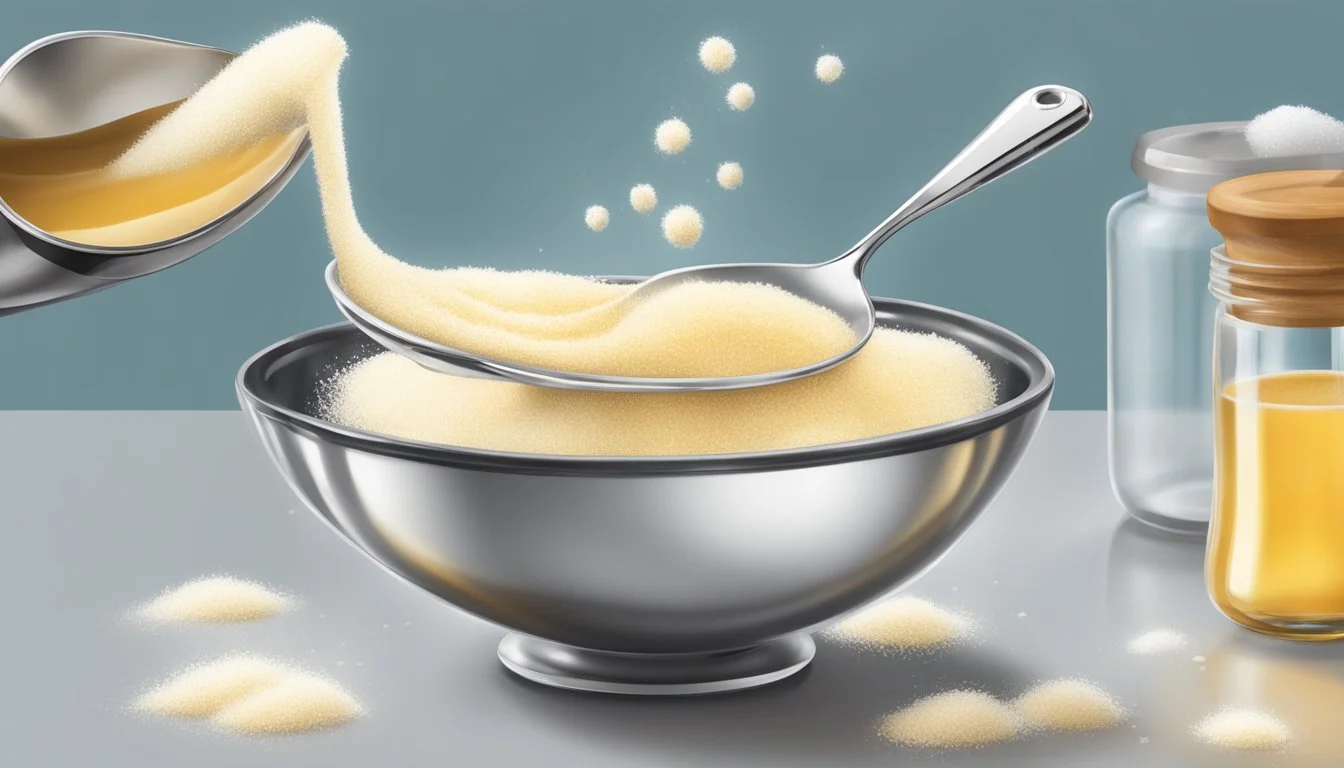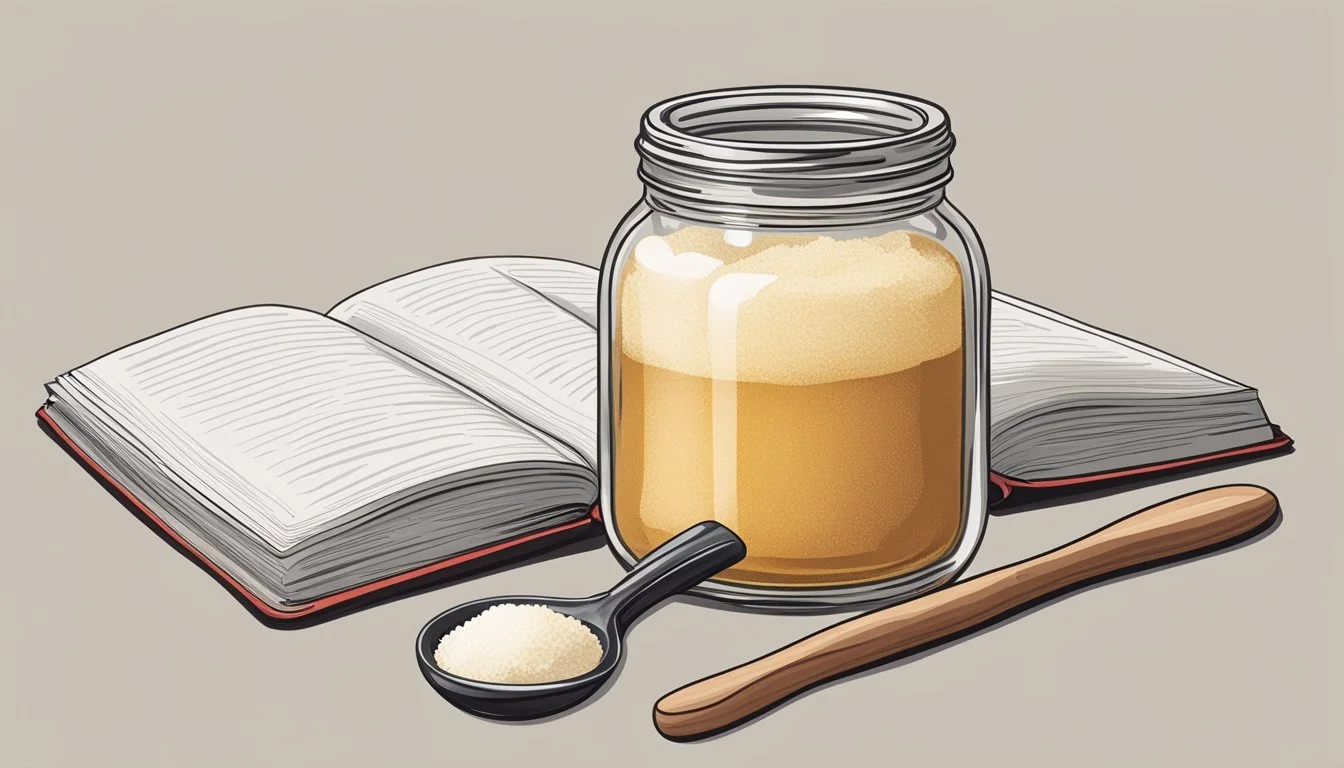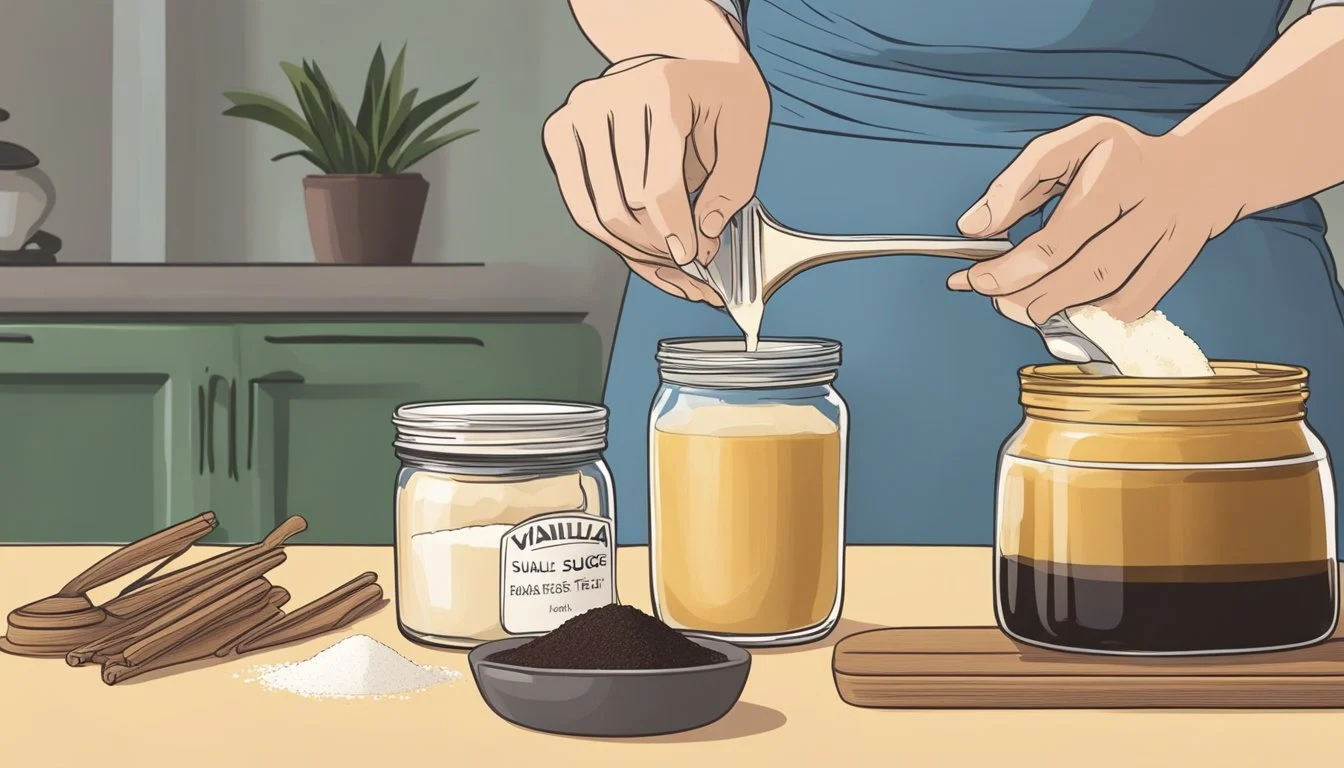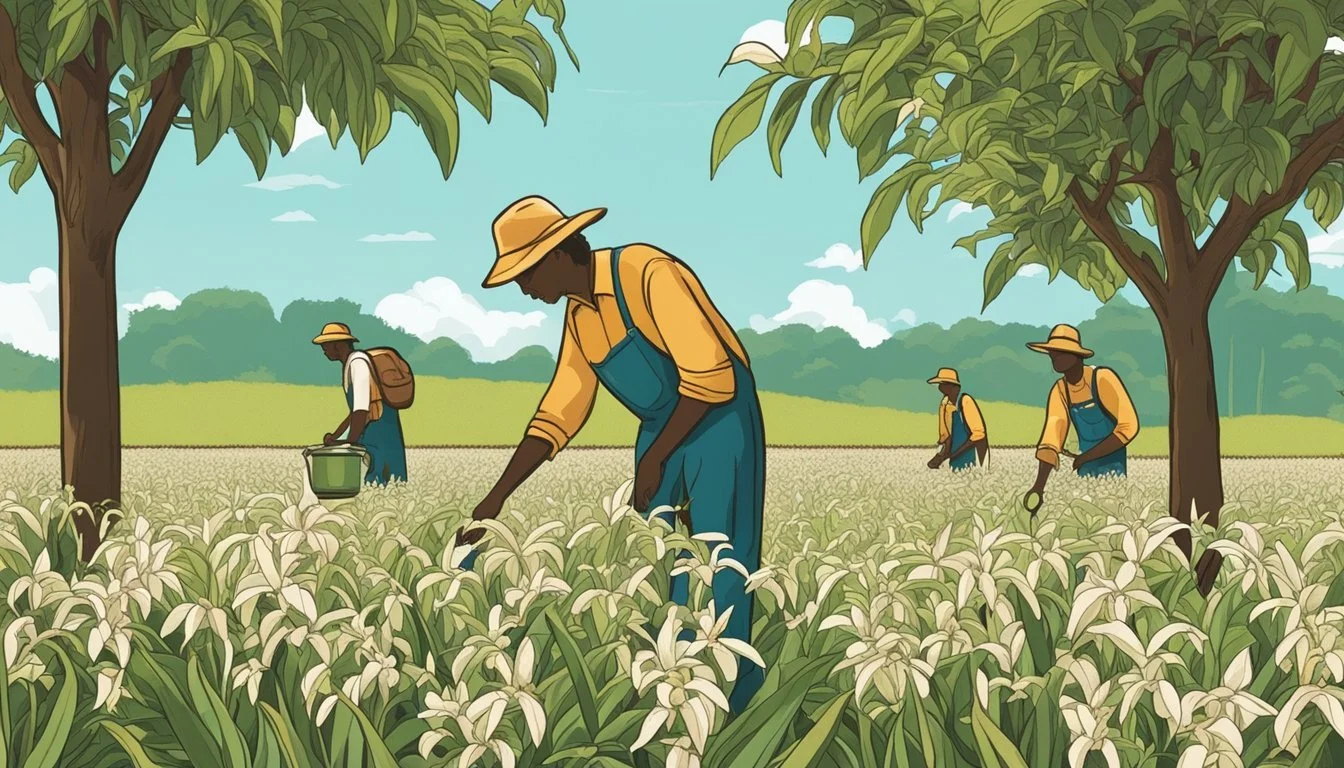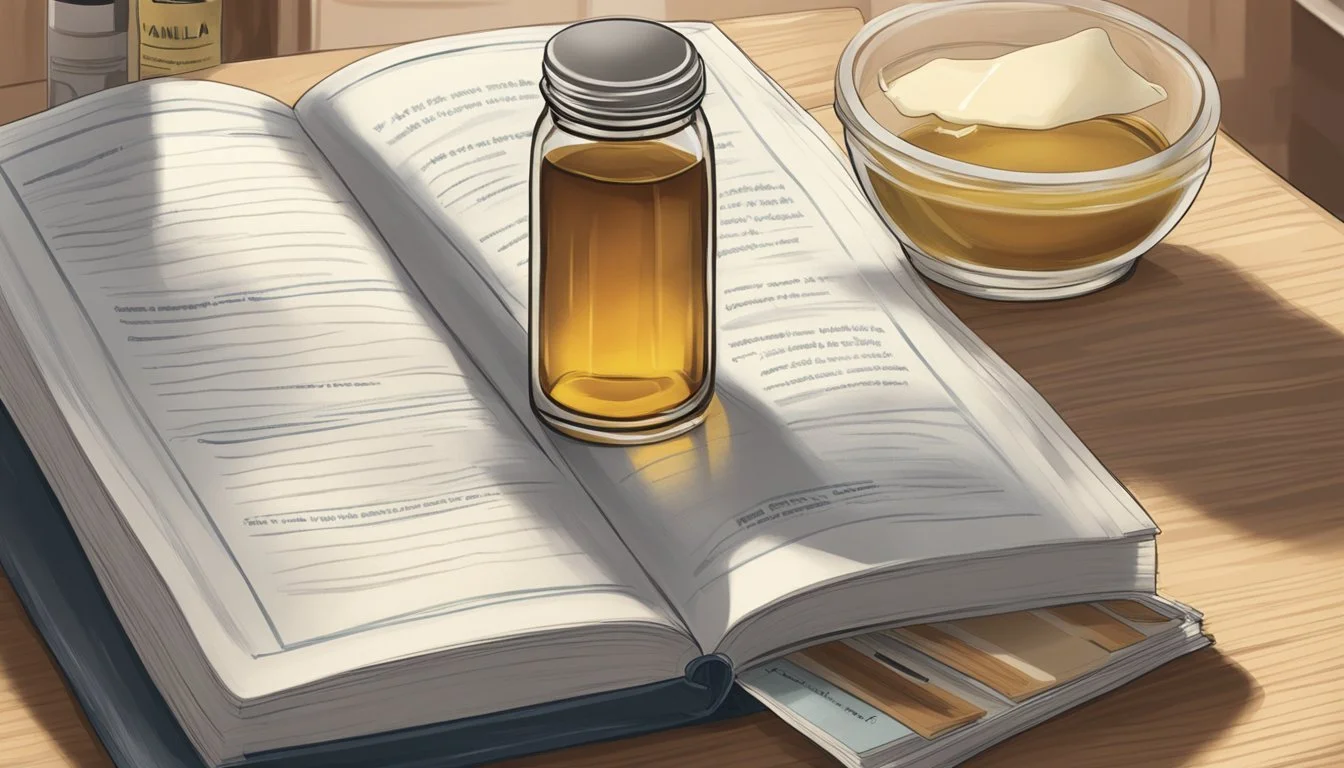How to Substitute Vanilla Sugar for Vanilla Extract
A Simple Guide
Vanilla is a staple flavor in a wide array of sweet treats, from cakes and cookies to custards (how long do custards last?) and creams. While vanilla extract—a concentrated form made by macerating and percolating vanilla beans in a solution of ethanol and water—is commonly used for its potent flavor, vanilla sugar is also a versatile alternative that infuses a subtle vanilla essence into desserts. Vanilla sugar is essentially granulated sugar that has been infused with vanilla beans, and its application can go beyond just replacing vanilla extract; it adds an aromatic sweetness to any recipe calling for regular sugar.
When substituting vanilla sugar for vanilla extract in recipes, a common ratio is 1 and 1/2 teaspoons of vanilla sugar for every teaspoon of vanilla extract. In doing so, it is important to maintain the recipe's balance by adjusting other liquid ingredients to account for the absence of the liquid extract. As this incorporated sugar can alter the sweetness and the moisture content, an extra teaspoon of liquid per 1 and 1/2 teaspoons of vanilla sugar should be considered to achieve the desired outcome.
The ability to interchange vanilla sugar and vanilla extract offers culinary flexibility, yet the exchange requires a conscientious approach to achieve the intended flavor profile and texture of the dish. Chefs and home cooks should be mindful that while vanilla sugar imparts a more muted vanilla flavor, it can simultaneously enhance the overall sweetness, making it an excellent choice for recipes where a pronounced vanilla essence is not the dominant flavor, but an accompanying one.
Understanding Vanilla
When it comes to enhancing the flavor of sweet dishes, the role of vanilla is indispensable. This section will elucidate the fundamentals of vanilla and its various forms, helping readers to navigate their subtleties with ease.
Vanilla Basics
Vanilla originates from the seed pods of certain species of Orchidaceae, a family of flowering plants. The most commonly used species for extracting vanilla is Vanilla planifolia. The lengthy and labor-intensive process of cultivating and curing the vanilla beans contributes to its status as the second most expensive spice after saffron.
Primary Producers: The leading producers of vanilla include Madagascar, Indonesia, and Mexico.
Pollination: The vanilla orchids are pollinated by either specific species of bees or, more commonly in cultivation, by hand.
Different Forms of Vanilla
Vanilla is available in multiple forms, each bringing its own intensity and complexity to recipes.
Vanilla Beans: The most pure and unprocessed form of vanilla. A single bean is split and scraped to extract the seeds, which contain the full spectrum of vanilla flavor.
Uses: Ideal for infusing creams, custards, and sugar.
Vanilla Extract: A solution created by steeping vanilla beans in alcohol to draw out the flavor.
Intensity: Typically, one tablespoon of vanilla extract is equivalent to one vanilla bean.
Alcohol Content: The extract contains alcohol, which can affect the flavor of a dish if not cooked off.
Vanilla Sugar: Sugar that has been infused with vanilla, either by mixing with vanilla extract or by storing with vanilla beans.
Conversion for Baking: To substitute vanilla sugar for vanilla extract, use 1 1/2 teaspoons of vanilla sugar for every teaspoon of vanilla extract, compensating with an additional teaspoon of a liquid ingredient.
Usage Recommendation: Suitable for recipes where a subtle vanilla flavor is desired without the addition of liquid.
Exploring Vanilla Sugar
Vanilla sugar is a versatile ingredient that can enhance desserts and sweeten beverages. This section covers the essence of vanilla sugar and easy steps to create it at home.
What is Vanilla Sugar?
Vanilla sugar is simply granulated sugar that has been infused with vanilla flavor. It can be used as a direct substitute for vanilla extract in many recipes. The degree of vanilla flavor depends on the method of infusion and the amount of time the vanilla has been allowed to meld with the sugar.
Primary Components:
Granulated sugar
Vanilla flavor (from vanilla beans or vanilla extract)
Creating Homemade Vanilla Sugar
Creating homemade vanilla sugar involves infusing granulated sugar with vanilla. One can start with fresh vanilla beans or vanilla extract, though using beans is the most traditional method.
Method with Vanilla Beans:
Split one or two vanilla beans down the middle to expose the seeds.
Scrape the seeds into a jar of granulated sugar.
Bury the split vanilla pods in the sugar.
Seal the jar and shake it to distribute the vanilla seeds.
Store the jar in a cool, dark place, allowing the flavor to develop over several weeks.
Method with Vanilla Extract:
Mix 1 tablespoon of vanilla extract with 2 cups of granulated sugar.
Spread the mixture thinly on a baking sheet.
Allow it to dry, then break up any clumps.
In both methods, the resultant flavored sugar has a shelf life of several months, provided it's kept in an airtight container away from heat and moisture.
Vanilla Extract Insights
In this section, we will explore the specifics of vanilla extract, including its definition and how one can prepare homemade vanilla extract.
What is Vanilla Extract?
Vanilla extract is a solution made by soaking vanilla beans in a mixture of alcohol and water. The primary purpose of this extract is to infuse the vanilla flavor into culinary dishes. The alcohol acts as a solvent, extracting the natural flavors and oils from the vanilla pods. Typically, ethanol is used due to its effectiveness in extracting flavors while being food-safe. Vanilla extract is a staple in baking and is favored for its rich, complex flavor profile.
The alcohol content in vanilla extract usually hovers around 35%, with the remaining being water and vanilla bean components. Popular alcohols used for making vanilla extract include:
Vodka: Due to its neutral flavor, it is the most common choice as it doesn't interfere with the pure vanilla taste.
Bourbon: Adds a unique warmth and depth to the vanilla extract.
Rum: Provides a sweet and slightly spiced note to the extract.
Homemade Vanilla Extract Preparation
To prepare homemade vanilla extract, one needs only a few vanilla pods and a choice of alcohol. The process is straightforward but requires patience for the flavors to mature.
Here is a simple guide to creating homemade vanilla extract:
Choose Your Alcohol: Select the preferred alcohol base (vodka, bourbon, or rum) as per the desired flavor outcome.
Prepare Vanilla Beans: Use approximately 3 to 5 vanilla beans per cup of alcohol. Split the beans lengthwise to expose the inner seeds.
Infusion: Place the prepared beans in a clean glass bottle or jar and cover with alcohol, ensuring that the beans are completely submerged.
Seal and Store: Tightly seal the container and store it in a cool, dark place. Shake the bottle occasionally.
Time to Mature: Allow the mixture to sit for a minimum of 8 weeks, though several months is preferred for a more robust flavor.
The result of this process will be a homemade vanilla extract that can enhance the flavor profile of a variety of recipes.
Substitution Fundamentals
When substituting vanilla sugar for vanilla extract, a cook must account for differences in flavor intensity and volume. They must adjust recipes to ensure balance and proper sweetness.
Conversion Ratios
For every teaspoon of vanilla extract a recipe calls for, 1 1/2 teaspoons of vanilla sugar can be used. Because vanilla sugar is less potent in flavor compared to the extract, the increase compensates for the difference in flavor concentration. Additionally, to maintain the liquid balance in the recipe, one might need to add an extra teaspoon of a liquid ingredient for every 1 1/2 teaspoons of vanilla sugar applied.
Considering Flavors
Vanilla sugar imparts a more subtle vanilla flavor compared to the extract. When using vanilla sugar, one should consider the flavor profile of the dish. Since vanilla sugar combines sweetness with vanilla flavor, it might subtly alter the taste balance in the final product. For dishes where vanilla is a secondary note, vanilla sugar works well, but if the robust flavor of vanilla extract is desired, additional flavor adjustments may be necessary.
Baking Considerations
When substituting vanilla sugar for vanilla extract, bakers must carefully consider the outcome on the texture and flavor of baked goods. The balance of dry to wet ingredients is particularly sensitive in items like cakes and cookies.
Impact on Baked Goods
Vanilla sugar, made by infusing granulated sugar with vanilla, adds a subtle aroma and flavor to desserts. In cookies and pies, where sugar also contributes to the structural integrity, substituting vanilla sugar for vanilla extract can enhance the vanilla essence without significantly altering texture. However, the replacement ratio should be mindfully applied:
For cakes and softer baked goods: Replace each teaspoon of vanilla extract with 1 1/2 teaspoons of vanilla sugar. Compensate for the liquid loss by adding an additional teaspoon of a liquid component.
The sweetness of the baked goods may slightly increase due to the added sugar, so bakers can consider reducing the overall sugar content if preferred. It's essential to evenly distribute the vanilla sugar within the dough to ensure consistent flavoring throughout.
Alternative Flavorings in Baking
Bakers may choose to use alternative vanilla flavorings when vanilla extract is unavailable. Each option carries a distinctive potency and can influence the final product in diverse ways.
Vanilla Flavoring Alternatives:
Vanilla powder: Intensely flavored, use 1/2 teaspoon per teaspoon of vanilla extract.
Vanilla bean paste: Due to its concentration, generally substitute in a 1:1 ratio with vanilla extract.
Whole vanilla bean: One bean is often the equivalent to approximately three teaspoons of vanilla extract.
It's crucial for bakers to acknowledge that these substitutes come with varying degrees of vanilla intensity and may impact the moisture balance in desserts. As such, adjustments should be made meticulously, especially in delicate baked goods like doughnuts, where flavor and moisture play critical roles in the final texture.
Recipe Adjustments
When substituting vanilla sugar for vanilla extract in recipes, the key is to maintain the balance between the flavors and the consistency of the dish.
Modifying Recipes for Substitutions
When a baker intends to use vanilla sugar instead of vanilla extract, they should be aware that for every teaspoon of vanilla extract, approximately 1 1/2 teaspoons of vanilla sugar should be used. This substitution works primarily in baking, where vanilla sugar can both flavor and sweeten the item.
In cooking, if vanilla extract is unavailable, one must consider whether vanilla is a central flavor. If so, replacing the extract with a like amount of vanilla sugar could slightly alter the texture and sweetness of the final dish. It's important for the cook to adjust other sweeteners in the recipe accordingly to avoid an overly sweet taste.
Recipes often call for liquids alongside the vanilla extract. In such cases, for each 1 1/2 teaspoons of vanilla sugar used, it's prudent to add an extra teaspoon of the recipe's liquid ingredient to compensate for the extract's moisture. This helps to preserve the original consistency of the recipe.
Specialty Vanilla Products
In the realm of baking and cooking, specialty vanilla products like vanilla bean paste, vanilla powder, and vanilla syrup provide unique flavors and convenience for those looking to substitute vanilla extract. Each product offers a distinct taste profile and usage applications that can enhance a variety of dishes.
Vanilla Bean Paste
Vanilla bean paste is a thick paste that includes ground vanilla beans, providing the rich flavor profile of vanilla along with the classic speckled appearance that comes from the seeds. It is often used in recipes as a direct substitute for vanilla extract. As a general guideline, one can replace 1 teaspoon of vanilla extract with 1 teaspoon of vanilla bean paste.
Vanilla Powder
Vanilla powder is made by grinding dried vanilla beans into a fine dust. It is pure vanilla with no alcohol or sugar added, lending itself well to dry mixes and liquid-sensitive preparations. To substitute vanilla extract with vanilla powder, use approximately half a teaspoon of vanilla powder for every teaspoon of extract required in the recipe.
Vanilla Syrup
Vanilla syrup is a liquid sweetener infused with vanilla flavor. It's commonly used to flavor beverages but can be an alternative to vanilla extract in some dessert recipes. The substitution is generally considered to be a 1:1 ratio, but one should consider the additional sweetness the syrup introduces to the dish.
Additional Substitutes
When substituting vanilla sugar for vanilla extract, one may consider other flavorful alternatives. Each substitute comes with its unique properties and proportions, aimed at achieving the intended flavor profile in recipes.
Almond Extract
Almond extract, when used as a substitute, delivers a nutty flavor reminiscent of marzipan. Proportions: Use a half teaspoon of almond extract to replace every teaspoon of vanilla extract, considering its potent flavor.
Maple Syrup
Maple syrup can offer a subtle, earthy sweetness when vanilla is not available. Pure maple syrup is preferred over imitation due to its natural and richer flavor. Proportions: Equal parts of maple syrup can be used in place of vanilla extract. Replace one tablespoon of vanilla extract with one tablespoon of pure maple syrup.
Other Extracts
Bakers can also use a variety of other flavored extracts found in their pantry. Options include:
Chocolate Extract: A rich alternative for chocolate-based desserts.
Citrus Zest: Lemon or orange zest can provide a fresh, tangy flavor in lieu of vanilla.
Honey: This can add a floral sweetness. Use in the same amount as vanilla extract.
Cinnamon: It brings a warm spice to the recipe, suitable for a teaspoon-for-teaspoon swap.
When using these substitutes, it's important to consider the liquid content they add to the recipe, which can slightly alter the texture of the final product.
Culinary Applications Beyond Baking
While vanilla sugar is commonly used in sweet baked goods, its aromatic sweetness can also enhance beverages and savory dishes, offering a subtle complexity to a variety of culinary creations.
Vanilla in Beverages
One can elevate the flavor of a simple vanilla-flavored milk by mixing in vanilla sugar to taste, which imparts a rich aroma without the liquid addition of an extract. Vanilla sugar also proves versatile in hot drinks; a sprinkle can transform a morning cup of coffee or add depth to espresso powder or instant coffee. Furthermore, homemade vanilla liqueur can benefit from vanilla sugar, providing a sweet base and pronounced vanilla essence.
Vanilla Ice Cream: Mix vanilla sugar directly into the base before churning for an intensifying vanilla presence.
Custards: Incorporate vanilla sugar into custard mixtures for desserts such as crème brûlée or panna cotta.
Savory Cooking with Vanilla
Vanilla sugar can impart an unexpected flavor twist in savory dishes as well. Chefs may introduce vanilla sugar into sauces for a touch of sweetness or use it as a seasoning for proteins like seafood or poultry to create a balance between sweet and savory notes.
Glazes: Vanilla sugar can be added to a glaze to brush on ham, chicken, or pork.
Seafood: A dash of vanilla sugar can enhance the natural sweetness of scallops (What wine goes well with scallops?) or shrimp.
Global Vanilla Production
Vanilla is a highly valued spice derived from orchids of the genus Vanillaplanifolia. The majority of the world's vanilla comes from Madagascar, but regions like Tahiti and Mexico also contribute to the global market, each offering unique varieties with distinct flavors and characteristics.
Madagascar Vanilla
Madagascar, an island nation off the southeast coast of Africa, is the most prolific producer of vanilla beans. Renowned for its Bourbon vanilla, Madagascar accounts for about 80% of the world’s supply. The vanilla produced here is highly sought after for its rich, creamy flavor and is considered the standard for high-quality vanilla. Madagascar’s humid and tropical climate provides ideal conditions for growing vanilla bean pods, which are hand-pollinated and cured through a labor-intensive process.
Tahiti Vanilla
Tahiti, located in the South Pacific, offers a different type of vanilla known as Tahitian vanilla. It comes from a distinct species, Vanilla tahitensis, which is shorter and plumper compared to its Madagascar counterpart. Tahitian vanilla is cherished for its floral and fruity nuances, with less of the classic vanilla flavor that's associated with the Bourbon variety. It is rarer and often more expensive due to its unique aroma profile and the smaller scale of production.
Mexican Vanilla
Mexico, the birthplace of vanilla, produces Mexican vanilla, which has its own unique and smooth flavor. The country contributes a smaller proportion to the global vanilla market, but the vanilla produced here is characterized by a spicy, woody taste. Mexican vanilla beans, similar to Madagascar beans, grow from the Vanillaplanifolia orchid but develop a distinct flavor profile due to the region's terroir. Despite its historical roots as the origin of vanilla, Mexico’s current production is far less than Madagascar’s, yet it's still valued for its high quality.
The Science of Vanilla
Vanilla is not merely a staple flavoring agent but is an intricate substance with a complex chemical makeup. It is primarily sourced from the cured seed pods of the orchid genus Vanilla, principally from the species Vanilla planifolia. Understanding vanilla’s chemical composition reveals its natural intricacies, while comparing synthetic and natural vanilla illustrates the differences in flavor profiles and applications.
Vanilla's Chemical Composition
The primary component that gives vanilla its characteristic flavor is vanillin (4-Hydroxy-3-methoxybenzaldehyde), which is just one of over 200 flavor compounds found in natural vanilla. In addition to vanillin, other notable compounds include 4-hydroxybenzaldehyde, 4-hydroxybenzoic acid, and vanillic acid. Real vanilla extract, sourced from the pods of whole vanilla beans, contains this complex array of compounds that contribute to its rich and nuanced flavor.
Notable Flavor Compounds in Natural Vanilla Vanillin 4-hydroxybenzaldehyde 4-hydroxybenzoic acid Vanillic acid
Synthetic Vs. Natural Vanilla
There are key distinctions between synthetic vanillin and naturally extracted vanilla flavor. Synthetic vanillin is primarily produced from lignin or guaiacol and is used in imitation vanilla flavorings. While it replicates the prominent flavor of vanillin, it lacks the depth provided by the other compounds in natural vanilla.
Synthetic Vanillin:
Cheaper to produce
Lacks complexity of natural vanilla
Common in imitation vanilla flavor products
Natural Vanilla:
Derived from whole vanilla beans
Contains an array of flavor compounds
Richer, more complex flavor profile
Natural vanilla extract, therefore, offers a flavor that is robust and multidimensional, contrasting with the singular note of synthetic vanillin found in imitation vanilla flavor products. The choice between using synthetic or natural vanilla products often depends on one's flavor preference and application intent.
Conclusion
Substituting vanilla sugar for vanilla extract is a reliable option when one is crafting baked goods and requires a vanilla flavor without the liquid content of extract. Chefs should consider the type and quality of their ingredients to ensure the intended outcome in flavor and texture.
Substitution Ratio: When using vanilla sugar in place of vanilla extract, a general guideline is to use 1.5 teaspoons of vanilla sugar for every teaspoon of vanilla extract required in the recipe.
Adjusting Liquid Content: It's important to compensate for the liquid discrepancy that arises when omitting vanilla extract. To maintain moisture balance in the mixture, an additional teaspoon of a liquid ingredient, which could be water, milk, or any other liquid present in the recipe, should be added for every 1.5 teaspoons of vanilla sugar used.
Flavor Intensity: Vanilla sugar tends to offer a more subtle flavor compared to the potent profile of vanilla extract. Individuals may choose to slightly increase the amount of vanilla sugar for a more pronounced vanilla taste, particularly in recipes where vanilla is the dominant flavor.
The baker must always keep in mind that the substitution may slightly alter the sweetness and texture of the final product, as sugar not only provides flavor but also contributes to the structure and browning in baked goods. Therefore, slight adjustments may be needed based on the specific recipe and desired outcome.
In conclusion, the nuanced use of vanilla sugar as a substitute for vanilla extract can be a successful method within one's baking repertoire, as long as these considerations are thoughtfully integrated into the preparation process.


